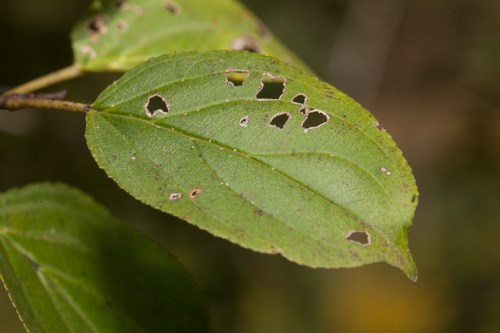
IntroductionThe European common buckthorn is a shrub or small tree that can reach a height of 25 feet (7.6 m). The trunk can grow up to a diameter of 10 inches (25 cm). The crown has no regular shape and differs between each shrub or tree. The bark is gray to brown and becomes rough in older shrubs and trees. When cut, the inside is yellow to pink. Many of the branches end with a conspicuous spine. Each plant grows purple-black berries up to 1/4 inches (0.6cm) in diameter, which resemble blueberries. Each fruit contains about 3-4 seeds. Leaves are round on one end and become pointed toward the tip. Both sides of the leaf are smooth, and the top of the leaf is darker green than the underside. One of the attributes that shows the hardiness of the common buckthorn is its ability to remain green in the fall, while most trees has already lost their leaves. As the name implies, European common buckthorn is a native of the northern parts of Europe and Western Asia. It has also been found as far south as Morocco and Algeria. Due to its hardiness and ability to survive a variety of soils and conditions, it was an ideal plant to use as hedges during the second half of the 19th century. Its initial introduction was along the eastern part of the United States and it soon spread westward and into Canada. It often invades locations where plant growth is favorable, thus woodlands and savannas are its targets, but it may sometimes be found in open fields and prairies as well. In some locations, the European common buckthorn becomes so 'common' that to remove it would mean destroying an entire area. In this case, it may be better to just leave it alone. Because the fruit of European common buckthorn causes a severe laxative effect, its seeds can be quickly distributed by birds, which is the main way of dispersal. These seeds are hardy and can outlast the seeds of native plants, giving it an advantage over natives. Once it becomes established in an area, it quickly crowds out native plants. While it is crowding and blocking the necessary sunlight to native plants, it may also release chemicals into the soil to suppress the growth of native plants, a process called the allelopathic effect. Find ItCrosby Farm Regional Park Want to Help Us Better Understand the Park?See our iNaturalist project, "The Life of the Mississippi National River and Recreation Area" and contribute to it by downloading the iNaturalist app and uploading your sightings of this species, and others, to the project. You can also upload your sightings from your computer. |
Last updated: March 22, 2018
